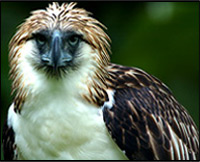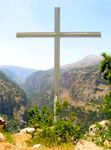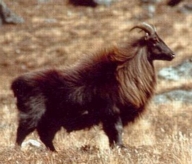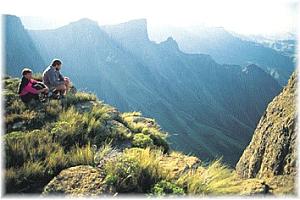WWF and ARC publish book highlighting sacred protected areas
December 18 2006:
 |
 |
 |
Philippines Eagle: protected in the sacred Mt Apo park on Mindanao |
WWF-International and ARC have published a ground-breaking document titled Beyond Belief exploring the role that faith can play in the protection of sacred forests, mountains, rivers, lakes, seas and deserts.
The document contains a list of the 100 sacred places, which are also places of vital biodiversity, protected by the people who believe in them. It is part of a joint WWF-International/ARC programme launched at the World Parks Congress in Durban in 2003, with the aim of having the term and concept of "Sacred Land" recognised as an international term of protection.
It comes in a year of excellent publications on faiths and the environment, including the World Bank's latest major publication with ARC titled Faiths and the Environment, published in 2006. (Please note this is a very large file, of 6.1MB). Link here for more information about ,
For the complete Beyond Belief document, including case studies, arguments for further protection, and warnings about the need for further, more specific guidelines, please download the whole document here. Meanwhile here is the WWF list of 100 sacred places, which are also places of vital biodiversity, protected by the people who believe in them:
1. Argentina: Lanin National Park, sacred to the Mapuche Indians, and famous for rare monkey puzzle trees.
2. Australia: Kata Tjuta National Park (within which lies Ayers Rock). Traditional, and managed by its traditional aboriginal owners.
 |
 |
 |
The sacred Qadisha valley in Lebanon |
3. Australia: Kakadu National Park in the Northern Territory. Traditional, and the subject of controversy because of plans to mine uranium on sacred land.
4. Australia: Deen Maar Island. An indigenous protected area which was badly degraded when it was purchased. Each winter people from Melbourne are invited to plant trees.
5. Australia: Gulaga National Park. Traditional. The report includes a detailed case study.
6. Bhutan: Jigme Dorji Wildlife Sanctuary. Bon and Buddhist, and the home of snow leopards, Himalayan musk deer, takins, blue sheep and Himalayan tahr.
7. Bolivia: Sajama National Park, sacred to the Aymara Indians.
8. Bolivia: Kaa-lya del Gran Chaco, sacred to the Guarani Indians and the largest protected area in South America, home to more than 69 species including the 140 remaining guanacos in Bolivia.
9. Bolivia: Isiboro-secure, traditional sacred park.
10. Botswana: Tsodilo Hills, sacred to the Kalahari Bushpeople.
 |
 |
 |
The protected Himalayan tahr, in Bhutan |
11. Brazil: Tumucumaque: sacred to indigenous Indians, largely unsurveyed but with many endangered species.
12. Bulgaria: Rila National Park: Christian site of the Rila Monastery, including half of Bulgaria’s plant species and 1/3rd of all vertebrates.
13. Cambodia: Angkor. Hinduism and Buddhism, and one of the most important archaeological sites in South East Asia. Needs more protection urgently.
14. Cambodia: Phnom Prich Wildlife Sanctuary. Traditional sacred “spirit forest” which appears to be the home of wild tigers.
15. Cambodia: Phnom Nam Lyr Wildlife Sanctuary. Traditional sacred stone at 1300m above sea level, in a 47,000 ha park, threatened by illegal logging.
16. Cambodia Phnom Kulen National Park. Traditional and Buddhist site, through which a businessman has recently built a road and toll gate.
17. Cameroon: Bakossi proposed National Park, includes many traditional significant sacred sites.
18. Canada: Klin-se-za - of great significance to the First Nations of NE British Colombia.
19. Canada: Kootenay. Home to grizzly and black bear, wolves, coyotes, cougars, bighorn sheep.
20. China: Xishuangbanna National Park in Yunnan province. Home to minority groups including Han and Dai, with up to 100,000 ha of sacred groves (5 percent of the surface)
 |
 |
 |
Drakensberg in South Africa, sacred to the San Bushmen |
21. China: Mount Tai Shan Scenic Beauty zone. A Daoist and Buddhist sacred mountain, home to tremendous bio-diversity, and threatened by tourism and pollution.
22. China: Tiebu Nature Reserve in Sichuan. A Buddhist site, and also home of the mountain god Da-Au, which is the last refuge of the Sichuan spotted deer.
23. Colombia: Laguna de la Cocha, sacred to traditional people, home to the endangered tapir, Northern pudu and spectacled bear.
24. Colombia: Purace National Park: traditional to local people.
25. Colombia: Sierra Nevada de Santa Maria, described in a case study.
26. Costa Rica: Arenal, sacred to traditional believers and home to a unique ecology.
27. Cote D’Ivoire: Comoe National Park and the largest protected area in West Africa
28. Cote D’Ivoire: Tai National Park in which relict forests have survived because considered sacred.
29. Czech Republic: Certova Stena – a Christian and traditional site.
30. Ecuador: Cayapas Mataje, with the world’s tallest mangroves.
31. Egypt: St Catherine – sacred to Christians, Muslims and Jews. Detailed in a case study.
32. Estonia: Otepaa LP, recognised by the Dalai Lama and home to rare orchids, black stork, osprey and white-backed woodpeckers.
33. Finland: Northern Karelia. Christian site described in a case study.
34. Finland: Pyatunturi National park, sacred to Lapps and with rocks dating back 2 billion years.
35. Ghana: Boabeng Fiema Monkey Sanctuary: in a sacred grove.
36. Greece: Meteora Monasteries, with many rare bird and animal species, including black storks and grey wolves.
37. Guatemala: Tikal, sacred to Mayan Indians, home to many endangered species indlucing the ocellated turkey and Morelet’s crocodile.
38. India: Great Himalayan National Park near to Manali. Hindu and Buddhist site that is one of only two places in India with a marked population of western tragopan; also home to Himalayan tahr..
39. India: Periyar Tiger Reserve: A Hindu sacred site, discussed in greater detail in the report.
40. Indonesia: Sulawesi Poboya Palu Forest Park, considered sacred to its indigenous residents, and used for special ceremonies connected with nature.
41. Indonesia: West Timor, a traditional site for the Meto people, and a critical watershed for the island.
42. Israel: Mt Carmel, sacred to Jews
43. Israel: Baram, near to a rare natural kermes oak forest.
44. Israel: Hermon River Nature Reserve, sacred to Christians.
45. Japan: The Shinto Sacred Forest of Kashima, or Deer Island. Primeval forest, home to 800 species of trees and rich birdlife.
46. Japan: Chubu Sangaku National Park: A Shintu site in north central Honshu Island, including one of the major sacred mountains of Japan.
47. Japan: Kii Mountain Range, sacred to Shintos and Buddhists, and the site of important ancient trees, including 108ha of protected Magnolia sieboldi
48. Japan: Itsukushima shrine, in the Seto inland sea, regarded as one of the finest Shinto shrines in Japan, and also a Wildlife Protection area.
49. Japan: Nikko National Park. A Shinto and Buddhist sacred place.
50. Japan: Mt Hakku National Park: a religious mountain for Shintos and Buddhists, home to the unique Altherbosa tall herbs
51. Kenya: Mt Nyiro Forest reserve, sacred to the Samburu.
52. Kenya: Mt Kenya National Park, sacred to the Kikuyu and Meru but threatened by illegal cutting. Refuge for elephant, rhino, cape buffalo and primates.
53. Laos: Nakai Corridor, on a limestone karst plateau, protected for centuries as a royal hunting reserve, and sacred to local indigenous villagers.
54. Lebanon: Harissa Forest, owned and protected by the Maronite Church.
55. Lebanon: Qadisha: the Holy Valley, detailed in a case study, and also one of ARC’s projects.
56. Madagascar: Lac Tsimanampetsotsa: Traditional and home to radiated tortoise and some 28 endemic bird species.
57. Madagascar: Amber Mountains – a vital rain catchment area in which the Cult of Nature is observed by local people.
58. Madagascar Sokoantovo proposed park, including 5 lemur species.
59. Malawi: Nyika National Park, containing several sites important for rain-making ceremonies, including one of the largest high grassland plateaux in Africa. Reedbuck, eland, roan antelope, zebra etc.
60. Malaysia: Kinabalu National Park on Sabah, sacred to the Kadazan Dusun people, and home to the highest mountain in Southeast Asia, with as many as 6000 species of flora, including many endemic species.
61. Mali: Cliffs of Bandiagara, centre for the Dogon.
62. Mexico: Wirikuta reserve: traditional to the Huichol people.
63. Mexico: Lagunas de Montebello, with limestone sinkholes.
64. Mongolia: the Bogd Khan Mountain, sacred to Buddhists and detailed in a case study.
65. Mongolia: Dornod Mongol Protected area, sacred to Buddhists and home to up to a million Mongolian gazelle.
66. Mongolia: Khovsgol Lake, sacred to Buddhists who call it the “mother sea”.
67. Mongolia: Terelj National Park, known to Buddhists as God’s Hill, and a place of hiding for Chinggis Khaan. Many poachers.
68. Nepal: Sagarmatha National Park, holy to Buddhists, and including Everest, and 152 species of birds, 36 of them rare or endangered.
69. Nepal: Annapurna conservation area, sacred to Hindus and Buddhists, home to snow leopards.
70. New Zealand: Tongariro National Park, sacred to Maori.
71. Nigeria: Sacred Groves of Oshogbo, and one of few high primary rainforest areas in the country.
72. Panama: Kuna Park, “Forests are sanctuaries where the spirits hang their clothes from the tops of the tallest trees. If they cut the trees, the spirits will punish them.”
73. Peru: Machu Picchu. Home to the spectacled bear.
74. Peru: Vilcanota, the first Natural Sacred Site in Peru.
75. Peru: Lake Titicaca, an Inca and Quechua sacred site.
76. Philippines: Mt Apo Natural Park, sacred to local tribes, and immensely important ecologically, home to the Philippines eagle.
77. PNG: Hunstein Range Wildlife Management Area, sacred to local tribes.
78. PNG: Madang Lagoon, area of the richest coral and saltwater fish biodiversity on the planet and believed to be the dwelling place of sea spirits.
79. Russian Federation: Yuganskiy Kanthy: Christian site with more than 10 valuable fish species.
80. Solomon Islands: Tetepare Island, containing 11,880 ha of virgin rainforest; sacred to local people, but uninhabited.
81. South Africa: Limpopo Modjadji Reserve, said to include one of the most unique floras in Africa
82. South Africa: Mapungubwe World Heritage Site meaning “a place of the stone of wisdom”.
83. South Africa: Richtersveld National Park, home to the world’s richest desert flora.
84. South Africa: Natal Drakensberg national park, sacred to the San Bushmen.
85. Sri Lanka: Yala National Park: Sacred to Buddhists and Hindus, renowned for the variety of its wildlife.
86. Sri Lanka: Peak Wilderness Sanctuary including Adam’s Peak and sacred to Hindus, Budhists, Muslims, Christians and Chinese indigenous believers.
87. Sri Lanka: Kataragama Sanctuary, sacred to Hindus, Muslims, Christians and Muslims
88. Sri Lanka: Mihintale, sacred to Buddhists.
89. Sri Lanka: Sinharaja Forest Reserve, sacred to Hindus and Buddhists and home to the last viable area of primary rainforest on the island.
90. Suriname: Central Suriname: sacred to the Werehpai.
91. Sweden: Laponian area, sacred to Sami.
92. Tanzania: Misali Island Marine Conservation Area – a Muslim area discussed in detail in a case study.
93. Tibet: Parsa Wildlife Reserve: Buddhist, Bon, Jain, Hindu sacred site including the holy mountain of Mt Kailash.
94. Turkey: Goreme National Park and Cappadocia. Sacred to Christians.
95. Turkey: Agri Dagi: Christian and Jewish site, believed to be the resing place of Noah’s Ark
96. Turkey: Altindere Vadisi: Christian monastery and rich site of rare trees and animals including chamois, wolf, jackal and wild cat.
97. Uganda: Kibale National Park, including mountain gorillas.
98. USA: Coconino National Forest, sacred to 13 Indian tribes.
99. USA: Wupatki National Monument, sacred to the Hopi, with pinyon pines and one-seeded junipers.
100. Yemen: Socotra Island, a Christian site with global significance for island biodiversity.
|

